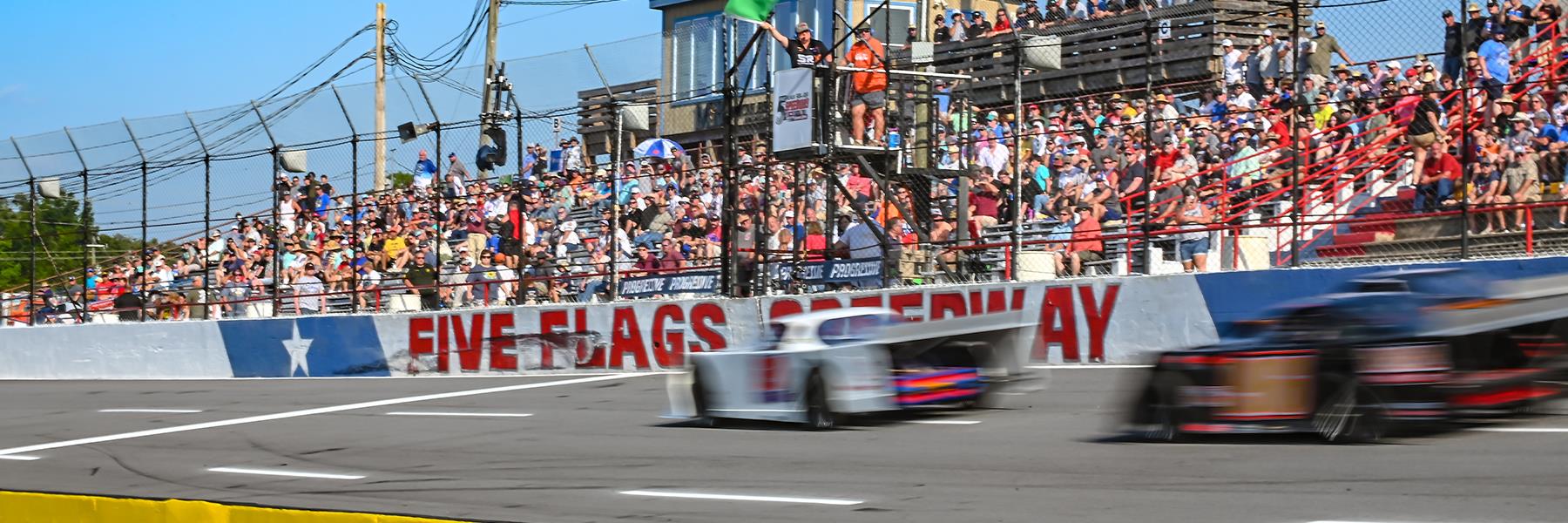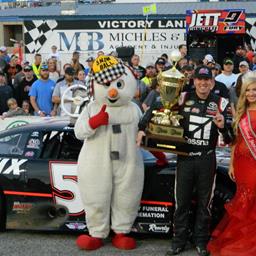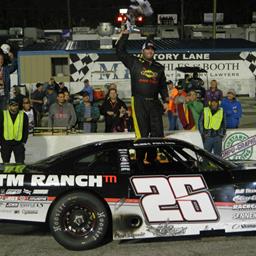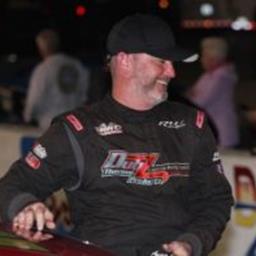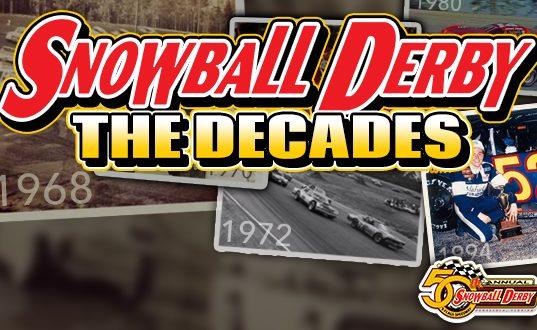
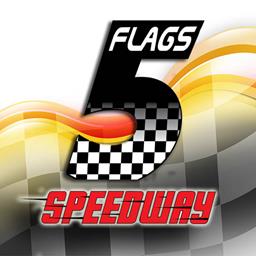
11/23/2017
Five Flags Speedway
Decade-by-Decade Look at the Snowball Derby: 1970s
 As we continue to close in on the 50th Annual Snowball Derby, we at Speed51.com continue our look at the history of the event through the years. Our newest feature takes you through the race decade-by-decade and give you a look at each year’s race.
As we continue to close in on the 50th Annual Snowball Derby, we at Speed51.com continue our look at the history of the event through the years. Our newest feature takes you through the race decade-by-decade and give you a look at each year’s race.
Today we take a look at the 1970s, a decade which helped shape the future of the Snowball Derby. If you missed our look at the 1960s, you can catch up on that by clicking here.
December 13, 1970
Pole Winner – Dave Mader (19.66 seconds)
Race Winner – Wayne Niedecken (Second win)
Weather – Windy with temperatures in the 60s
Special Note – Only 12 of 36 cars finished the race as tires were pushed to the limit.
The risk and reward grew for the third annual Snowball Derby. The race was extended to 200 laps and $2,250 awaited the winner in victory lane. When the dust settled, Wayne Niedecken established himself as the first repeat winner of the race. He took the lead on lap 183 when Chuck Arnold had a flat tire. Niedecken told local newspapers,“It was just a game of luck and that’s why I am standing here today.� Dave Mader lost a tire off his car and it went sailing across Pine Forest Road, striking a camper which was heading north. Mader was taken to a local hospital for observation.
December 13, 1970
Pole Winner – Dave Mader (19.66 seconds)
Race Winner – Wayne Niedecken (Second win)
Weather – Windy with temperatures in the 60s
Special Note – Only 12 of 36 cars finished the race as tires were pushed to the limit.
The risk and reward grew for the third annual Snowball Derby. The race was extended to 200 laps and $2,250 awaited the winner in victory lane. When the dust settled, Wayne Niedecken established himself as the first repeat winner of the race. He took the lead on lap 183 when Chuck Arnold had a flat tire. Niedecken told local newspapers,“It was just a game of luck and that’s why I am standing here today.� Dave Mader lost a tire off his car and it went sailing across Pine Forest Road, striking a camper which was heading north. Mader was taken to a local hospital for observation.
December 12, 1971
Pole Winner – Donnie Allison (19.57 seconds)
Race Winner – Dickie Davis
Weather – Light winds, temperatures in the low 70s
Special Note – 1971 was the first protest of the win at Snowball Derby. Protests would dominate the headlines in the 1970s at the Pensacola track.
Hold all scoring cards. Dickie Davis’ win in the 1971 Snowball Derby was on hold after Freddie Fryar protested the win. Fryar finished second and swears that he was the leader; however, the deciding factor in the race was that Davis spun and visited the pits for fuel before coming back out in front of the leaders. Fryar admitted part of the confusion was that the scorer could not inform the team of their running position. To this day Fryar believes he won the race, but Davis still has the trophy.
December 10, 1972
Pole Winner – Ed Howe (18.80 seconds)
Race Winner – Ed Howe
Weather – Mostly cloudy with temperatures in the 70s, cooling off later in the day
Special Note – Some consider this race the changing of the guard with the likes of a built race car car winning for the first time, which would end up being a sign of things to come.
The field of cars grew up into the 90s as the first true outsider invaded Pensacola and won the race. Michigan’s Ed Howe survived the race’s second protest when Darrell Waltrip and Buck Simmons asked for a check of the scoring. Two hours later, Howe had the trophy and was heading north. Simmons told the local papers that his crew informed him to take it easy in the closing laps. Because of that, he allowed Howe and Waltrip to pass. It was not the first time and it would not be the last time someone had their heart broken in the final laps at the Snowball Derby.
December 9, 1973
Pole Winner – Pete Hamilton (18.29 seconds)
Race Winner – Dickie Davis – Second Win
Weather – Temperatures in the low 60s and cloudy
Special Note – Davis became the second two-time winner. It would be eight years before that feat would be accomplished again.
For the third year in a row there was a protest of the winner, but this time it was not a scoring issue. The complaint about Dickie Davis’ second Snowball Derby win was the fact that he couldn’t have gone 200 laps on a tank of gas. Thus, the fuel tank was the subject of the protest. Davis was cleared when the tank was refilled and found to be legal. Polesitter Pete Hamilton was forced to make adjustments after his engine was found to be shifted. It cost him a chance at a win and he vowed to return and set a new record the following year.
December 8, 1974
Pole Winner – Pete Hamilton (18.14 seconds)
Race Winner – Pete Hamilton
Weather – Cool with temperatures in the 60s
Special Note – Dickie Davis charged from 26th to finish second in a bid for a third Derby win.
Pete Hamilton was a man of his word after stating that he would return to break the track record; he did just that. He followed it up by sealing the deal and winning the Snowball Derby. Hamilton led 102 of the 200 laps as he became the first driver to win the Daytona 500 and the Snowball Derby. Hamilton, at this point, became the third driver to win the race from the pole.
December 7, 1975
Pole Winner – Bobby Allison (17.85 seconds)
Race Winner – Donnie Allison
Weather – Cloudy with temperatures in the 70s
Special Note – Over 107 cars tried their hand at the 1975 Snowball Derby.
An all-time record 50 cars started the 1975 Snowball Derby with well over 100 trying to make the big show. Bobby Allison set fast time as he and his brother Donnie Allison combined to lead all 200 laps at the Snowball Derby. In the end it was Donnie Allison who got the win after Bobby Allison lost a lap following a feud with Ronnie Sanders. The feud left Sanders in handcuffs and Bobby out of contention.
December 5, 1976
Pole Winner – Billy McGinnis (17.57 seconds)
Race Winner – Darrell Waltrip
Weather – Cloudy with temperatures in the 60s
Special Note – Pole speeds decreased nearly a full second from the 1972 race. McGinnis was almost a half second better than Hamilton in 1974.
The protests returned in 1976 when Darrell Waltrip picked up the win after a scoring mess in which caution laps were not counted as a result of the 96 laps that were run under yellow the year before. Harry Gant and Freddie Fryar each thought they had scored the win, but several drivers reviewed the score cards after 200 laps and left satisfied enough to think that Waltrip had indeed won. The field was cut from 50 to 45 starters to ease the attrition.
December 4, 1977
Pole Winner – Ed Howe (17.53 seconds)
Race Winner – Ronnie Sanders
Weather – Partly cloudy with temperatures in the mid 70s
Special Note – The race was extended to 250 laps. This was short lived as it would go back to 200 laps a few years later.
The fans left the race track thinking that Darrell Waltrip had won the Snowball Derby for the second straight year. However, a check of the scoring in the tower proved that Waltrip made up a lap in the pits and Ronnie Sanders was indeed the winner. To this day, Waltrip still has the original trophy and Sanders has the money. A second trophy was issued to Sanders the following spring.
December 3, 1978
Pole Winner – Billy McGinnis 17.50
Race Winner – Dave Mader III
Weather – Cold with high temperatures around 45 degrees
Special Note – Mader becomes the youngest winner in Snowball Derby history, a record that would stand until 2004.
The first youth movement at the Snowball Derby came in the likes of Dave Mader III and Mark Martin. The two drivers dominated the 1978 Snowball Derby. Mader snuck by Martin with two laps to go and hung on for the win. Mader at 23 years old was considered a youngster, but the last decade has been littered with teenagers winning the Snowball Derby.
December 2, 1979
Pole Winner – Jody Ridley – (17.05 seconds)
Race Winner – Freddie Fryar
Weather – Cool with temperatures in the 60s.
Special Note – 33 of the 36 starters ran Chevy Cameros. There were two Mustangs and one Pontiac.
Butch Lindley dominated the day, but in the end it was 43-year-old Freddie Fryar who proved he had all of the tools to be a Snowball Derby winner. Fryar won 28 of 32 races prior to the Derby that year and he never thought he would be a factor until he took tires late and got to the lead on lap 182. From there, he raced into the Snowball Derby record books. Jody Ridley and Butch Lindley protested their finishing results, but not the win. No changes were made.
Back to News